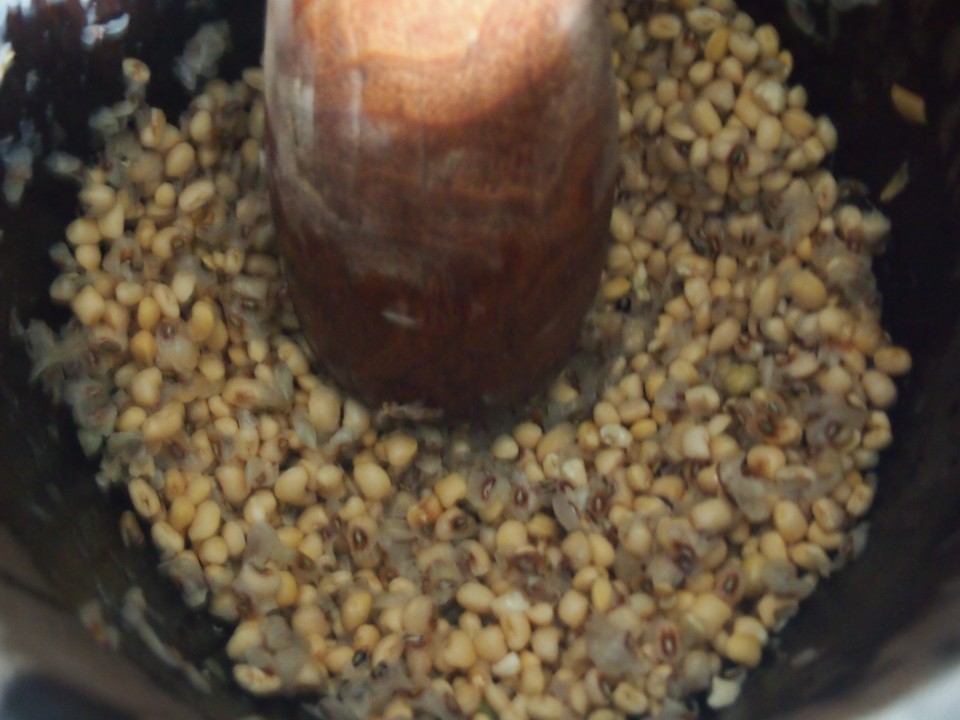The ‘Nigerian brown bean’ (also known as ‘Honey Beans’ or ‘Brown Beans’, Vigna unguiculate) is a brown variety of black-eyed peas. Its distinctive sweet taste forms the basis of many dishes: akara, moi-moi, agwa (ewa), adalu and gbegiri. The Yorubas refer to it as ‘Oloyin’, meaning honey. Black-eyed peas are an acceptable substitute.
Soaking dry beans for at least 6 hours or overnight reduces the cooking time AND helps reduce the flatulence often associated with legumes. The Chinese add ginger to legumes to reduce this unfortunate side-effect. I sometimes add ginger to my agwa for variety.
Salt slows down the cooking process and so should be added when the beans are ready. Some people use kaun to speed up the cooking process. Interestingly, an Indian friend told me that they add bicarbonate of soda to legumes such as chick peas to eliminate flatulence.

Honey Beans (left) & Black-eyed Beans
Peeled Beans
Some recipes such as those for moi-moi and akara, call for the use of peeled beans to help make a lighter dish, although at the expense of the loss of some fibre.
It is possible to buy ready-peeled beans and this definitely makes life easier! Rehydrate them by soaking in cold water for several hours until they double in size. Rinse them in several changes of cold water, discarding any bean skins that float to the top.
If you are unable to buy them, soak the beans for 10 – 15 minutes in cold water. Test a couple of beans by rubbing between your fingers to see if the skin comes off easily. Please note that the longer you leave the beans to soak, the harder it is to skin them.
To skin the beans, rub handfuls of beans between your hands. Drain using a colander to remove the debris. Refill the bowl with cold water and repeat the process until the beans are peeled. It is not necessary to remove every single skin, but the more of the skins are removed, the lighter your dishes will be.

Peeled Beans: Dried (to the left) and soaked (note how they have almost doubled in size)
A liquidiser (blender) or a food processor may be used to skin the beans (the latter is preferable as you can process a larger amount of beans at a time):
- Soak the beans in cold water for about 5 minutes or so (you want to loosen the skins to soften but not soften the beans).
- Place a small amount of beans in your liquidiser with plenty of water so that the beans have enough room to move around.
- Using the pulse button and process for a few seconds. Repeat two or three times.
- Put the processed beans in a bowl with and skin the rest of the soaked beans.
- Cover the peeled beans with plenty of water and leave for a few minutes to allow the skins to rise to the top. Using a sieve or colander, drain away the skins and discard. You may have to manually peel a few stubborn ones by rubbing them between your fingers
- Repeat Step 5 until all the skins are are removed. Your beans are now ready to use in a recipe of your choice.
The traditional way of doing this is by adding a small amount of beans and water in a mortar and gently pounding with the pestle until the skins are peeled.
Bean Powder
Alternatively, commercially available bean powder may be used. To get the best results add the powder to the rest of the ingredients and blitz using a liquidiser to incorporate as much air as possible. Rehydrate the powder by soaking the batter for at least 2 hours. Whip it for at least 5 minutes just before cooking. This ensures a lighter batter.
Kitchen Hack
Save time by peeling beans and storing in the freezer where they will keep for up to 6 months. In my experience, if they are well-drained, you don’t even need to freeze them in small portions – just scoop out the amount you need for your recipe.
